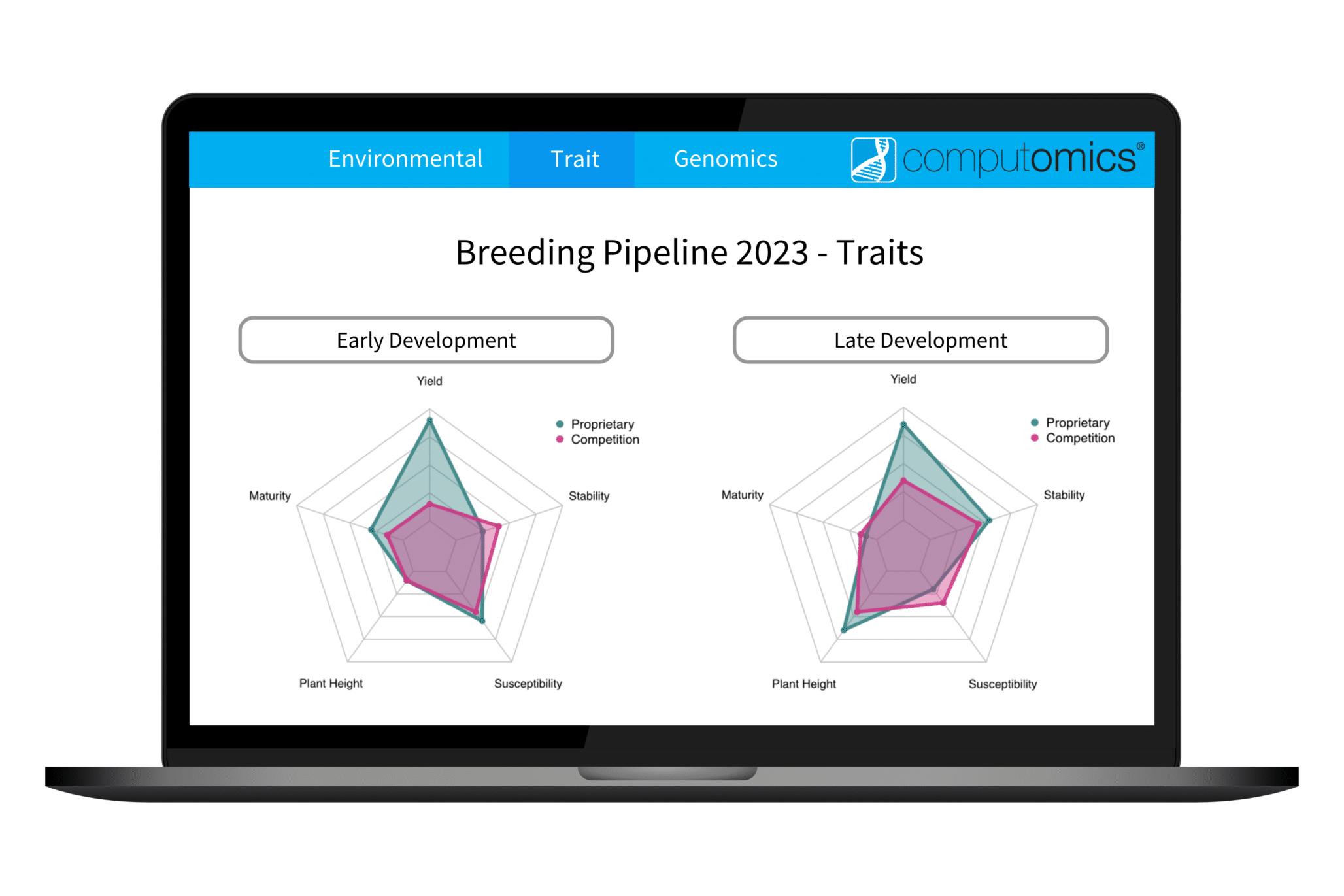Unlocking data-driven insights from your breeding pipeline to empower you to make informed decisions faster.
In today’s breeding programs, data plays a pivotal role in determining efficiency. Why? It boils down to the insights provided by genetics data, which empower breeders to create new plant varieties with a deeper understanding of their genetic makeup.

Before the advent of genomics, breeders relied solely on field experimentation and their intuition to select parent plants. However, with genomics, breeders gain deep insights into the genetics of parent plants that enable a more efficient breeding process.
In the era of big data, genetic information serves as a crucial resource empowering breeders to make informed, data driven decisions. As more breeding related data types (like DNA sequences, environmental variables like temperature, rainfall, radiation as well as information of soil composition and agronomic management) become available and rapidly accessible, the task of integrating this information gets more and more complex. However, genetic information allows for enhanced accuracy and deeper insights, when included in the data-driven decision process. Data offers breeders and managers of breeding programs the potential to:
Understand the germplasm diversity and the molecular level. One significant advantage of genomics is the ability to understand the molecular diversity available to breeders. By analyzing genetic data, breeders can categorize plants based on their genetic makeup. This understanding informs breeding program organization and helps relate current genetic diversity to breeder’s knowledge, potentially uncovering associations between traits and genetic groups.
Detect strengths and weaknesses. The wealth of data from breeding programs holds the potential to support data-driven actions. Combining the data, one can uncover highlights of a program that can be leveraged, as well as areas where further investment is required to stay ahead of the competition.
Use genomic prediction. This can be more cost-effective and timesaving than traditional phenotypic selection methods. It has the potential to double or triple the rate of genetic gain in a breeding program.
Harness the power of AI. For complex traits like grain yield in diverse environments, genomic data coupled with environmental data and artificial intelligence algorithms offers unprecedented predictive power. By leveraging historical data and advanced algorithms, breeders can forecast performance in new environments, accelerating breeding programs and enhancing efficiency significantly.
What is the Status Quo of Your Breeding Program(s)?
Aligning breeding pipeline performance with the commercial strategy is the goal of every breeding program. To achieve that goal, it’s crucial to gain a deep understanding of your breeding pipeline. Some key questions to consider are:
•How competitive is your current breeding program?
•What can you expect in the next years?
•How can you improve efficiency?
•What are the opportunities to grow your market share?
•Where do you have the best product-market fit?
Computomics’ BreedScope provides analyses to answer these questions offering valuable insights for decision-making:
Environmental analysis: Environmental clustering of field trials to understand environmental diversity in the field testing network enabling a deeper understanding of product performance and the environmental influence on traits in specific environments.
Trait analysis: Comparison of experimental and commercial varieties including competitors across various traits to gain a nuanced understanding of each trait’s performance, guiding strategic decisions aligning with your product positioning strategy.
Genomics analysis: Gain deep understanding of your germplasm diversity and structure to identify opportunities to create new products and shorten the time to market.
BreedScope equips you with a comprehensive understanding of your breeding pipeline, empowering you to make informed decisions faster.
Tailored to the specifics of your breeding program, BreedScope offers modular and scalable solutions. It can seamlessly be adapted to the size and complexity of the individual breeding program. With rapid results and actionable insights, it enables optimization of your breeding program.
Seeing the Future
Today, it’s crucial for breeders to anticipate and adapt to long-term changes and consider the future trends impacting the food production and supply chain.
Predicting what conditions will be like in five or 10 years when a variety hits the market is incredibly difficult, given the rapid pace of climate change and its impact on crop performance and disease dynamics. Also, consumers’ requests are changing.
Sustainability is another pressing issue. There’s a growing demand for agricultural practices that produce the same or higher yields while using fewer resources like water, fertilizers, and pesticides. Balancing productivity with environmental responsibility is a constant challenge.
Meeting the diverse needs of various stakeholders in the agricultural value chain adds another layer of complexity.
Climate-Smart Breeding with ⨉SeedScore® – The Next Step in Your Breeding Program
Understanding your breeding program’s competitiveness is a crucial first step. And then, consider incorporating climate-smart breeding technology ⨉SeedScore® to truly excel in today’s changing environment. ⨉SeedScore® integrates genomic information along with insights from field trials, such as grain yield, agronomic traits, quality, disease resistance, and environmental factors like temperature, rainfall, wind, and soil characteristics. Additionally, details regarding crop management during trials serve as valuable inputs. To improve the development of new varieties that succeed in specific current and future environments and climate situations, ⨉SeedScore® provides accurate performance predictions.
Armed with this predictive insight, breeders can strategically decide which hybrids, varieties or crosses to prioritize for field testing, potentially reducing testing costs and optimizing resource allocation.
Beyond cost-saving benefits, ⨉SeedScore® enhances the breeder’s understanding of Genotype × Environment × Management (G×E×M) interactions. This deeper insight sheds light on why certain genetic traits thrive in specific environments.
Start the Conversation
At Computomics, we recognize that breeding programs come in all shapes and sizes. Therefore we engage with a diverse range of breeding programs, catering to their unique individual needs. If breeding companies want to better understand their competitiveness of their breeding pipeline, identify opportunities for currently uncovered markets or increase efficiencies, BreedScope serves as the foundational step.
For larger programs, we facilitate the seamless integration of ⨉SeedScore® by running analyses on our servers and delivering predictions to support their implementation.
On the other end of the spectrum, smaller breeding programs often lack the necessary data infrastructure. Here, we play a pivotal role in helping them establish data collection processes for future use. Additionally, we assist in setting up molecular genotyping capabilities and offer advice on breeding strategies.
Our approach is highly adaptable, considering factors such as program size and crop type.
By understanding their unique circumstances and aspirations, we strive to contribute meaningfully to their journey, helping them navigate the ever-evolving landscape of agricultural technology and strategy.
Contact me at jmm@computomics.com and let’s have a conversation — it could be the beginning of taking your program to a whole new level.
For more information, click here to visit our website!













